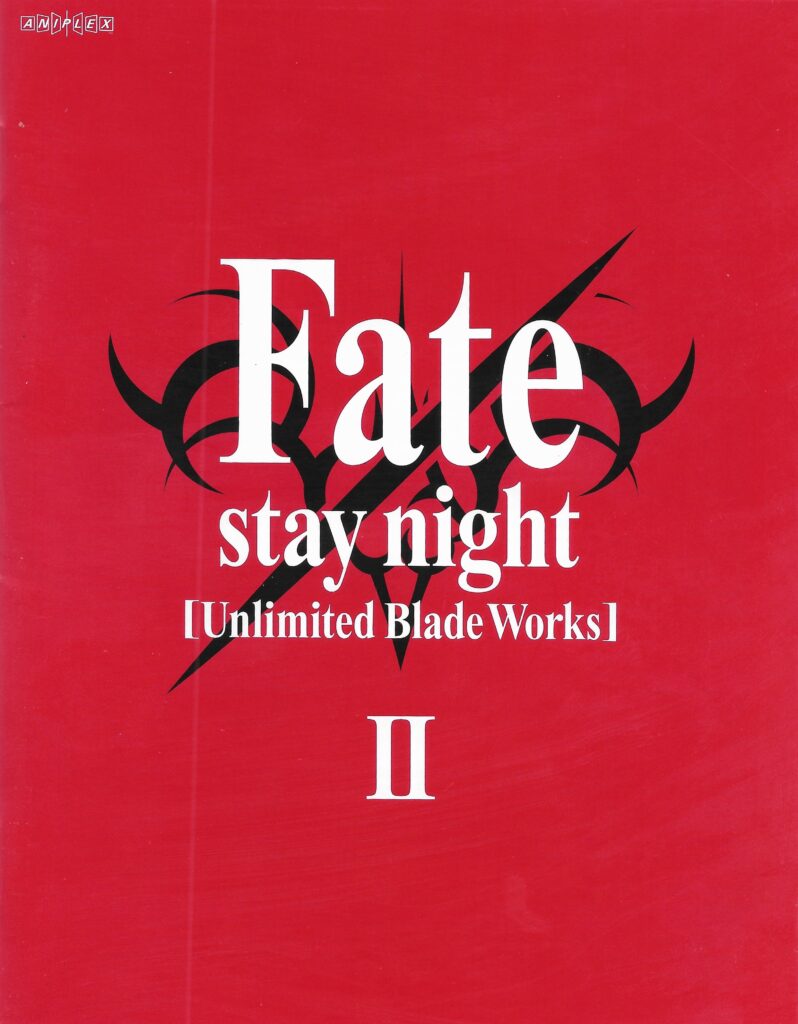
Introduction
Fate/stay night [Unlimited Blade Works]
This title is the second Blu-ray box set release for the TV anime series, Fate/stay night [Unlimited Blade Works], which aired from April to June 2015; it contains the second season of the show, picking up the latter half of the story.
Needless to say, like the first season, the show is based on the game by TYPE-MOON. And once again, the anime has been produced by ufotable. This is the same company that has brought various TYPE-MOON-related titles to the screen, starting with the Garden of sinners, a 7-part film series released between 2007 and 2010. With their innovative and vibrant storyboards, high-quality key animation and animation, the superb CG rendering that has catapulted them into the top echelon of animation production companies, and the camera techniques that encompass all these strengths, enabling them to capture the atmosphere of each scene, they have received accolades for every facet of their production work. And one of ufotable’s greatest strengths is said to be its team of talented, veteran staff members. For example, in the case of the Garden of sinners, they used seven different directors for each film, showcasing the impressive depth of their roster. Not only that, but there’s no question that it’s the sure-handedness of their talented staff – not just the directors – that makes ufotable’s trademark high-quality visuals possible.
The scope of their technical skills are no less on display in Fate/stay night [Unlimited Blade Works]. Originally a “Visual Novel Game” depicted through text and illustrations geared for computer monitors, this title worked precisely because of the TYPE-MOON staff’s boundless attention to detail during production, and because of the type of game it was. The screenwriter, Kinoko Nasu, wrote scenes in which the characters uttered lines that were at times eloquent, at times profoundly stirring; and players were drawn in by the onscreen effects and direction.
When they took on this title, the first thing ufotable did was draw out the strengths of the original, this time as an animated depiction. In other words, something bursting with compelling motion. Needless to say, Fate/stay night [Unlimited Blade Works] is a so-called “Battle-oriented title,” and its battle scenes surely blew its audience away, starting with the Archer vs. Lancer battle in #00 in Season 1. In particular, the numerous Noble Phantasms unleashed by the Servants, one after the other, with Lancer’s Gae Bolg topping the list, as well as Assassin’s Tsubamegaeshi (Ultimate Swallow Reversal), Gilgamesh’s Gate of Babylon, Archer’s Rho Aias, etc… These are all brought to life through every imaginable type of motion, and elaborate staging.
Longtime fans, not to mention viewers seeing this show for the first time, arc sure to find themselves stunned and excited in a new way: “So this is how they’re showing how this Noble Phantasm is put together?”
And if that weren’t enough, the battles only get more violent in the second half as the story goes on – it’s one battle after another. In other words, as Rin Tohsaka warned at the end of Season 1, “If you involve yourself any more, you’re going to die,” or perhaps like the warning Shirou Emiya disregards in #20 of Season 2, “Hell is up ahead,” the Season 2 Blu-ray box set contains episodes chock-full of perilous battles. ufotable has produced a show with great visual impact, incorporating all the attributes of those scenes: theatrical, shocking, and horrifying.
Such thrilling action scenes are the strong suit of Takahiro Miura, who directed the entire series; and surely they’re the highlights of this show. At the same time, however, it’s also a show that places great emphasis on the inner workings of its characters. Miura grasps this all too well, giving Shirou and Rin’s intimacy a sweet-and-sour vibe; Caster and Souichiro Kuzuki’s relationship a melancholic vibe; suffusing Archer’s loneliness with a quiet heaviness; portraying Shinji Matou as foolish and comical…each is depicted with great attention to detail. We see how each of these diverse relationships play out in Season 2, and neither too little nor too much time is spent on this aspect of the show.
Not only that, but for the production of this anime version of [Unlimited Blade Works], additional scenes and script supervision was provided by Kinoko Nasu himself. Episodes abound that never appeared in the original story: Illya and Berserker’s backgrounds and destinies; Caster’s parting with her former true Master, Atrum Galliasta; not to mention the London episode, which served as the epilogue. Not only has this pleased fans, deepening their understanding of the original story as well as of this show, but as standalone episodes, they lend the series a lovely, melancholic overtone, and viewers should find themselves even more moved.
And ufotable has kept churning out these lavish, beautiful visuals – 13 episodes for Season 2 alone, bringing the total of episodes they’ve produced from Season 1 to 26 in all. I’m sure there were viewers who, wide-eyed, marveled as they watched the broadcast, “Even though it’s a TV anime show, the quality is like that of a theatrical release.” It might not be good form to speak of it while comparing it to something else, but without question, this show is that polished and imposing. It actually seems appropriate to be astonished by the fact that one can see this every week as an anime show on TV.
But it’s not at all as if ufotable set out to paint this show with gorgeous visuals and direction, nor to please fans by adding elements not seen in the original story. What Miura is said to have been striving for was to merely drop everything that was good about the source material into the anime. Needless to say, novel games, made up of text and graphics, are essentially expressed differently than a visual medium like anime, so it’s impossible to reproduce an exact copy. Neither is there any point in creating something only slightly different. What he strove for here was to capture that feeling of playing the original game, the feeling of having read these lines written by Kinoko Nasu, the feeling of having seen Takashi Takeuchi’s artwork…all of those elements rising up out of the anime.
That’s precisely why you’ll see many instances in this show that are more than a nod to the atmosphere of the source material. That includes the characters’ dialogue. Generally speaking, the tone and phrasing of the dialogue found in the source material is often revised during the animation process, in order to quickly convey the characters’ intentions, as well as the flow of the story. And of course, it’s a given that dialogue will also be cut. This show has also undergone such polishing, but what strikes you even more than that is the fact that there are many lines that were lifted, as is, from the source material.
Kinoko Nasu’s writing and dialogue have a unique gloominess and smoothness, and the main characters’ emotions sometimes pierce through readers’ hearts; at other times, resonating slowly in a roundabout way. In addition, as I mentioned at the beginning of this article, as the original story is exceedingly wordy, one can see through all the rich dialogue how each character was formed. Normally, it would be extremely difficult to use such phrasing, as is, in an anime show. But ufotable understood that this kind of verbiage wasn’t merely excessive, it was actually what shaped every element of the world of the original story, and that it was what held it together. That’s what gave the characters’ narration a Kinoko Nasu-like allure, giving fans the feeling that they were being shown the world of the source material, unchanged, as an anime show, and drawing new viewers to the wonders of its world as well.
And it’s clear that ufotable poured all their efforts into making the confrontation between Shirou and Archer in #20, and what happened from that point till the final showdown in #24, the highlight of the story. Miura had always stressed, from before the start of Season 1, that these episodes contained highlights. But as you already know, this show boasts the highest quality from #00, its first episode; and these visuals would now reach the pinnacle of quality, as a vehicle for depicting the heart of the story.
And it’s not just a final battle that they’re showing – it’s what Shirou Emiya overcomes, and his parting with Saber, Archer and other Servants. In other words, while it’s certainly a story that shows each character’s most subtle emotions, it’s also the story of its main character, Shirou Emiya, as he strives to become a “fighter for justice.” As part of the Fate/stay night franchise, that’s exactly where you’ll find the singularity of this script called [Unlimited Blade Works]. And that’s why its beauty is so straightforward, why it moves whoever sees it. In other words, Miura had spotted its essence, accurately, from the start. That’s probably why he’d been so driven to pour all his efforts into the storyline from #20 onward, from before the start of Season 1.
ufotable has announced that it will be animating Fate/stay night‘s other script, Heaven’s Feel, for the first time, as a theatrical film. But before that happens, we’re going to get a chance to watch [Unlimited Blade Works], with still so much to savor and enjoy – the end result of the blissful meeting of this excellent original story and the animation staff, and all their single-minded efforts. The Blu-ray box before you now is a show like no other, incorporating the essence of the story, and produced at the highest quality currently possible.
The New UBW, Spawned by Our Conversations
Kinoko Nasu x Takahiro Miura
The Original Creator x Director Cross Talk
Kinoko Nasu (Scenario writer, novelist)
Major works include the games of Lunar Legend -Tsukihime, Fate/stay night, Witch on the Holy Night and the novels the Garden of sinners, DDD, etc.
Takahiro Miura (Animator, episode director)
Signed with ufotable. Director, the Garden of sinners – Chapter 6: Fairy Tale (Oblivion Recording). Director, Fate/stay night “Realta Nua” opening cinematic.
Nasu: Before the final episode aired, I re-watched the entire Fate/stay night [Unlimited Blade Works] (hereafter, UBW) TV anime series, and once again I was struck by how beautiful a film it was. But simply calling it “beautiful” might be cause for misunderstanding; since at heart, this story is a grim and gory one, “beauty” takes on a different meaning. It’s not about making it look dazzling overall; rather, there’s a single thread within the story, and that’s where you’ll see the beauty. When it was decided that this story would be animated, the director, Mr. Miura, told me, “I want to give form to the original story.” Personally, I thought that it would be difficult in the current climate to do this original story as is. So I remember going so far as to say, “What? That original story’s out of date now, so let’s not do that.”
Miura: But basically, I still wanted to follow the original story, as is. But for those of us on the animation staff, there were certain things, such as your intentions and emotions as you wrote that original story, what was behind all that…things we’d never understand unless we actually started working with you. So I think over the course of our conversations, the content of this anime changed drastically. In that sense, I don’t feel at all as if we adapted the original story as is. If you hadn’t been there, I would’ve done it as is. But now I feel as though we were able to create something new in the end, through all our discussions.
Nasu: That makes me happy…. I’m really happy. Watching the final episode, I was once again struck by how effortlessly you’d surpassed my initial concept. It’s embarrassing to say this aloud, but in a way, I’m Archer, and you’re Shirou. You said, “The Kinoko Nasu back then isn’t as bad as you say!” And ten years later, when I sulked about “this grim, gory story not being relevant anymore,” you pulled out all the stops to win me over.
Miura: Being able to hear from you firsthand all the information I could only glean from the text in the visual novel, such as Shirou’s state of mind, and what was going on in the background, really left a strong impression on me.
Nasu: We novelists can be arrogant, thinking, “If I do my job 100%, we can convey what we want to all readers.” But of course, there’s no way we can convey 100%. In fact, since every reader has different emotions, there are times when only 80%, or 120% gets through. But since anime is about creating visuals objectively, you all have to be on the same page throughout the production process. So it’s important to confirm with each other, “This is what this line means.” So I always went into our meetings trying to remember what it was like when I was writing the visual novel.
Thanks to this comment by Kinoko Nasu, Shirou changed in the final episode
Miura: What really left an impression on me after talking to you was, first of all, Shirou’s state of mind when he stabbed Archer with his sword in #21. That was where my perception of Shirou as a character changed. In that moment, Shirou isn’t just relentlessly going after Archer, thinking, I’m going to be a superhero; behind it all, there’s another emotion. In other words, Shirou is taking this action even as he realizes that what he’s doing is stupid. It’s extremely crucial that he realizes that his ideal of becoming a superhero is actually ridiculous. What you said to me then was, “That’s why Shirou’s a little bit scared to move forward.” Moving forward despite your misgivings. Knowing that Shirou harbored such emotions was huge for me. And it really influenced how I drew Shirou from #22 onward.
Nasu: The storyboards for that scene…initially, they showed Shirou raging more, bellowing heroically, didn’t they? I’m sure that a lot of people had that image in their minds. But personally, like you just said, I felt that this scene really had that “Actually, this is what was going through my mind when I wrote this” vibe, so I put a hold on it. This was something I couldn’t explain unless I did it orally, so I said, “I’m heading over to ufotable right now,” and then we discussed it together. I think the only time I said, “I’m heading over right now,” at an unscheduled time was then, and when we were working on the final episode.
Miura: I think that was the first time you wanted to hold an impromptu meeting.
Nasu: Since it was the backbone of the story, we needed to talk it over and make sure our visions were in sync. So I had you go out of your way to find time for me during crunch time. “I would be happy to leave the battle scenes to your discretion, but it’s just the facial expressions afterward that aren’t right. This is the one thing I really need you to change…” was the kind of back-and-forth we had.
Miura: Well, but that really did wonders for me. Till then, in my mind, Shirou was just this reckless guy who never thought about himself. But in fact, he’s acting on various other emotions. He seems like he’s too pure, and a little offbeat. That’s the kind of character he is, right? So I think deep down, he’s actually a I kind of guy. And that realization really affected my work going into the final episode. That conversation we had that day was like a turning point for me, as far as UBW was concerned.
Nasu: Then that really makes me happy. And the final episode was so good! But for me personally, there were a few things I would’ve changed about what I worked on. Like, “They made such gorgeous visuals, so why am I dragging it all down with the dialogue?” I felt really bad about that. From #22 onward, in particular, no matter how I tried, I couldn’t delete any lines. There were three kinds of lines – lines describing the worldview, lines describing the character delivering them, and lines necessary to describe the theme. And as far as this title was concerned, you couldn’t delete the theme-related lines. Even though I knew it would mess up the pacing, I couldn’t concede that. And I became stubborn about it. Since UBW has a storyline that goes all the way through, I was probably afraid that if I cut out the theme, it would end up being pointless…
Miura: But the dialogue you write is always so interesting to hear. In a typical anime, the lines would be extremely simple, and it would just be like the characters tossing words back and forth, but the Nasu style makes them sound so riveting.
Nasu: Usually, when I write a character, I become that character as I’m writing; I write the dialogue from a meta point of view: “With this personality, this is probably how he’d reply.” But doing it that way, you can’t help straying from cookie-cutter dialogue. You can usually see a person’s backbone in their words, but I wasn’t able to tune the balance for anime. I regret that.
Miura: But I was always extremely aware of the nuances in your lines. I taped the source text from the original game on my desk, and I would find hints from that as I worked. Even among the lines that you yourself might not have found to be that crucial, I found so many gems. So what I originally set out to do wasn’t any different, but like Shirou’s depiction, there might have been some aspects that did go through changes in the end. As for the final episode, I think we were able to show emphatically how Shirou had really thought his actions through. Always keeping in mind what you’d told me before we started work on this project – “Shirou never changes. He shows no growth whatsoever.” – but from #22 onward, we were able to show how he had this whole undercurrent of various emotions.
Nasu: By “Never changes” I didn’t mean that he never grew mentally, but that his theme never changes. Even knowing how absurd and contradictory it is, he says, “I’m going to become a superhero.” And actually, he himself suffers the most from saying such a thing. But he has no choice but to do it. So when he finishes off Archer, he’s on the verge of tears. After the final episode, he’s been through one battle, so he has grown mentally, but fundamentally, he hasn’t changed. So he’s a person who has to battle such self-contradictions. Also, people unfamiliar with the visual novel might wonder, “Well, then what happened to Archer?” On the one hand, his line, “I’ve found the answer” actually might not bring him any salvation whatsoever. He’s never, ever going to change, so even if Shirou leads a somewhat better life, Archer has no such blessing. When he says, “It’s all right, Tohsaka,” he’s only looking out for her feelings.

Faithful to the Original Story, Directed in that Unique Anime Style
Miura: Since before the start of Season 2, what I wanted to depict was the underplot regarding Illya. That’s why I made sure Illya made frequent appearances from Season 1. I just thought it would be better to touch upon Illya. Because people who weren’t familiar with the visual novel, let alone longtime TYPE-MOON fans, probably wouldn’t get it otherwise. And more importantly, since Fate/Zero had aired, I didn’t think having its main character, Kiritsugu’s daughter, pop up and then abruptly die, vanishing forever, would really fly. So I asked you to write the Einzbern’s backstory for the new series.
Nasu: Yes, you told me that you wanted to make episodes featuring Illya. It’s true that normally, Illya appears as a main character in the Saber route, but this time around there was no opportunity to tell any inside stories. So I suggested that if they were going to spend a whole episode on the Berserker battle, why not include the Einzbern story there?
Miura: It really hit home how hard it was to cover as much as possible from source material divided into three stories. Heaven’s Feel was already slated to be produced after this, so we didn’t really go into Kirei Kotomine’s background, though. Either way, for this title, we had to keep the other routes M mind throughout the production process. Also another thing you said was “Make sure that Gilgamesh never uses Ea against Shirou in #23.” That made me panic – “What?! What am I going to do, this isn’t good!” – more than anything else.
Nasu: Oh, I’m so sorry. But if he’d used it, it would’ve been difficult for Shirou (plus alpha) to block it on his own. Since it was just text in the visual novel, I was able to get away with it, but in an anime, with visuals, it would definitely look awkward… I mean, it would totally blow the cover of the one who comes to his aid. So I said to show Ea, but not use it, and said something along the lines of “What? Riddles?”
Miura: I really racked my brain over that. In the end, I made it so that even though the Ea was used, Shirou got caught up into it, and you’d think, “Huh? Did Shirou die?” In reality, the jersey he was wearing was what got killed.
Nasu: Oh, so that jersey is no longer with us, then?
Miura: But the characters’ wardrobe is important, after all. In #20, we do see Shirou remove his jacket. It just doesn’t click unless you see that visual. If he’d been wearing that jersey when he uttered the line, “Let’s go, the King of Heroes,” it would’ve looked out of place, so I checked out the timing. We have him remove it with a ripping sound in #24, too. So we were pretty conscious of when that jersey would meet its demise in the storyboards, well in advance. After that, in #20, you know that scene where Archer and Shirou are facing off, and Archer speaks while they have their backs to each other? We repeated the same situation from #07. Takashi Suhara, who directed both episodes, did that deliberately, but it never occurred to me to direct it that way, so that left quite an impression on me. I thought it was done well.
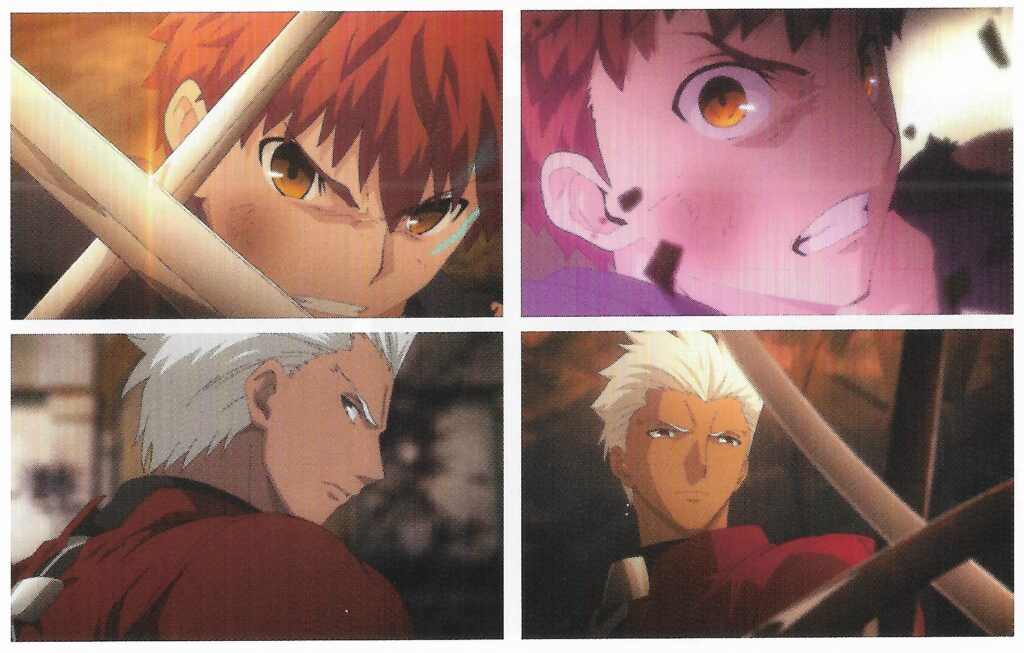
Nasu: But I remember asking during #07, “Why did you make these kinds of visuals for this scene? Don’t you think they’re too close together? Wouldn’t it give more of a sense of distance if they were placed farther apart?” And you said, “There’s a reason for this.”
Miura: Really? I don’t remember that…
Nasu: Then it must’ve been.. you know. You already had the concept of them standing back-to-back in #20, but you hadn’t yet hit upon the idea of having Shirou get stabbed in the foot yet?
How the Gilgamesh Battle Became the Ultimate Final Battle
Miura: But when you look at it rationally, until #24, when Shirou says, “I don’t care if it’s fake,” he hasn’t awakened yet. So looking back, I’m glad that he truly gained his full powers around the battle with Gilgamesh. If he’d suddenly gone full power when he fought Archer, the Gilgamesh battle would’ve paled in comparison. You once told me, “The Gilgamesh battle is the moment when Shirou Emiya shines the brightest in his life.”
Nasu: It does seem like the peak of his life. In sports, I’m sure there are times when a lesser opponent gets the better of the one reigning at the top. And that’s not because he’s always had that ability, but because of various factors, like “I’ve really got it today,” or “When I get home today, I’m getting married.” When those things come into play, people can transcend their own specs. That’s why Gilgamesh says at the end, “Today you’re stronger.” For Gilgamesh, it’s not his life that he values, but what he modeled his legend on. The reason he didn’t want to use Ea was because if he’d done so against an inferior opponent, he wouldn’t have been able to face the heroes who’d been beaten by Ea. And yet, when he was unable to draw Ea against Shirou, Gilgamesh was clearly defeated in this Holy Grail War. Conversely, had he managed to draw Ea in time despite his hesitation, it would’ve been a heavier burden for Gilgamesh to bear than death.
Miura: You were the one who told me about Gilgamesh’s state of mind, and I explained it all to the episode director during the production process.
Nasu: And it was depicted so clearly. It was so cool! For the anime, #24 was full of things to worry about. As I’ve said repeatedly, the lies that could only work in the visual novel were all expressed in the Gilgamesh battle. So I wondered how they could be brought to the screen. The results speak for themselves. The battle to exterminate heroes exploded all over the screen, something you can only achieve with anime.
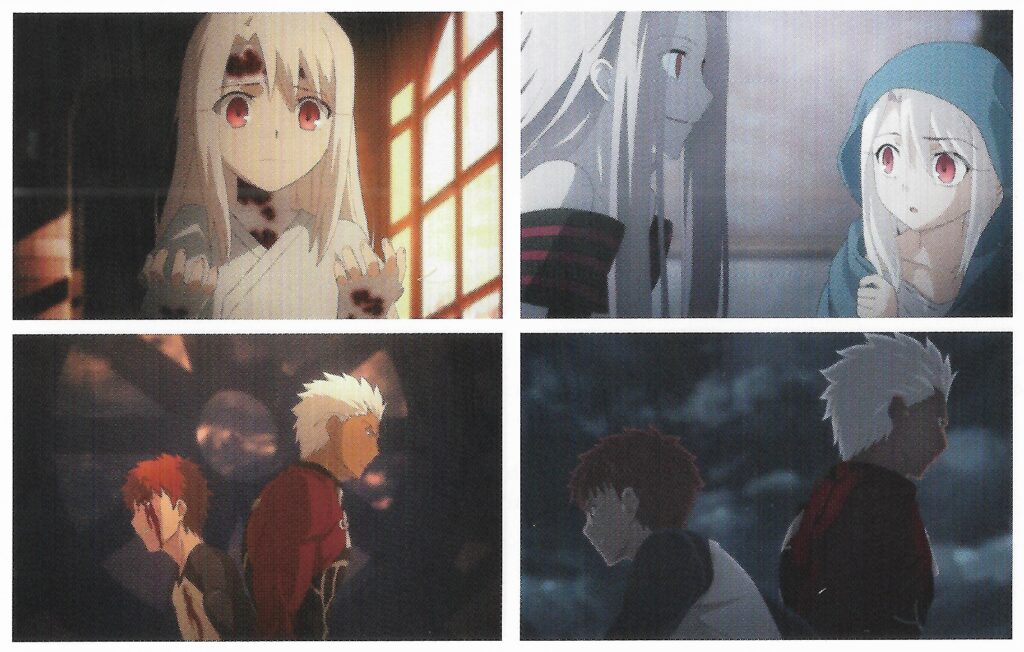
Miura: Production of Season 2 got really hectic in the second half. All I could think of was how to assemble a staff for #24, which I did by calculating backwards.
Nasu: Since the Archer vs. Shirou battle turned into a battle not of swords, but of words, the final battle against Gilgamesh became a 100% clash of power, with no words. The contrast was brilliant. Because we made Gilgamesh that unbeatable in the Berserker battle to have Shirou win without dropping Gilgamesh’s specs meant that the visuals had to look extra convincing. But that’s too high a hurdle…or so I thought, because look at the results. My apprehensions were completely groundless.
Miura: Among the staff, the issue was, “We have to make the battle eye-popping, but Shirou’s an ordinary human being, right?” So the episode director, Toshiyuki Shirai, and I were kind of agonizing over that. But Masayuki Kunihiro, who did the key animations, is a specialist when it comes to action scenes bursting with superhuman moves, so we decided to have Shirou really go on a rampage there.
Nasu: Animations -that ended up being what distinguished that scene from the Archer battle.
Miura: We redid the storyboards for that scene about three times, but since you’d told us, “Make it better than the Berserker battle,” there’s actually a scene mid-battle where Shirou’s camera angle traces the Berserker battle in #15. We flipped the camera there, and matched the rhythm and the steps to that Berserker battle. But you know how Berserker moved in front of Illya, which led to his defeat? When we had Shirou move forward, we were envisioning a continuation of the Berserker battle. So you could say that that action sequence was a result of one of your remarks.
Nasu: What’s that? That’s the skill of an artisan! I know I told you, “Good luck!” but you outdid yourself!
Miura: We made #24 running solely on determination. We just went at it full tilt. I realized how difficult it was to allocate staff to a 2-cour series.
Nasu: And the goal was to complete it at that high visual quality. Seeing it hold its own even on a 200-inch projector is amazing. Because that means that you could watch the entire series in a movie theater, and it would stand up just fine. As both the original creator, and as an anime consumer, I couldn’t be more grateful. And like I’ve said repeatedly, the UBW story is such a hard one to bring to the screen. I wish the characters could go on chatting merrily like they do in the final London episode, but that’s not what happens. Both the creators and the viewers have something heavy hanging over them. But it wouldn’t be UBW otherwise. I’m really impressed that you were able to see it through like this.
Going All-Out for the Show; Love Gave us our Final Power-Up
Miura: But especially in the case of #24, a lot of the staff members felt that it was going to work, even midway through production. So when we started the dubbing process (*1) it was pretty fierce. I mean you should’ve seen how gung-ho the episode director, Shirai, was. A recording session that would normally take 2 hours would go on for five or six. I’m sure he had his pride as director, and all of the staff members shared the view that for this episode, if you gave it your best shot, it would turn out well.
*1 – Dubbing session: The audio process; adding dialogue, sound effects, and background music to the visuals.

Nasu: So it was worth giving your best shot.
Miura: Yes. Like, “Let’s do Rin and Archer’s farewell scene in-house,” or “At least give Tomonori Sudou the visuals for the moment when Saber disappears at the end.” We already knew well in advance that #24 would be difficult to produce, so we actually started prepping around the time we started work on Season 2. In that sense as well, a lot more work went into #24 than any other episode. Shirai had long been slaving away at the desk next to mine. Since we couldn’t, under any circumstances, throw Rin and Archer’s farewell scene out of balance, he did the layouts himself, and everything else way in advance. The flow of Rin’s Ea, as well – he was re-doing them till the very last minute. That scene owes everything to his perseverance. The backgrounds were also done by the art director himself.
Nasu: If you’d just animated the text from the visual novel, that scene would’ve been only 2 minutes long. I thought it would be difficult to make a two-minute scene moving, but it turned out magnificently. At the time, I didn’t know how you were able to do that, but now, after hearing from you, I understand.
Miura: This title was like an all-out war. Shirai asked me to do a lot. And I animated the last three episodes myself.
Nasu: I thought so. I remember thinking when I saw the credits, “Hey, the director’s doing the key animation himself- is he gonna be okay? Wow!”
Miura: The truth is, right at the last minute, after I was done cutting (*2) I watched the battle scene, and there was something about that flow that just bothered me. Normally, at that point, you’re not supposed to add any extra tasks. But I thought it wouldn’t matter if the director did it himself, so I added some action to that scene and created a sequence.
Nasu: I see. You couldn’t have somebody else do it, “But hey, the director can do it himself!”
Miura: When I asked my staff, “Can I do this part?” they looked totally displeased and said, “What? But we’re done cutting, aren’t we?” and they argued against it. But I drew it next to the episode director, and pulled rank as director, saying, “Do this,” as I handed it over. That was the first time I’d ever forced something like that.
Nasu: Now you’ve got me even more anxious to see #24!
Miura: The parts I did are strewn here and there. But personally, I’m glad that I got to take part in #24, too. As an animator, it’s not often that you get the chance to work on such refreshing action-oriented episodes. Another thing I liked about this set was the fact that there were staff members who’d come up to me and say, “I want to do this scene because I like this character.” The staff members themselves feel affection for the characters.
Nasu: That makes me feel really, really grateful… These wonderful true stories that you only hear after it’s all over…
Miura: Like Shinji, for instance. As creators, it’s such a boon when you do something not because it’s work, but because you like it. That’s especially true when it’s a grueling shoot.
Nasu: In the end, the most powerful driving force is love, right?
Miura: I mean, for the production team, UBW really is an all-out war; it’s playing baseball, all hands on deck. The director doesn’t make all the decisions himself; I really feel as though everyone threw out ideas and maximized their respective skills.
Nasu: That might be why, but I always find UBW more fascinating the second time I watch it than the first. Since I have the whole story in my head the second time, I can see where the staff paid extra attention, and it makes it even more intriguing. So I hope that everyone who buys this Blu-ray boxed set watches it a second or even third time, and looks out for those spots.
*2 – Cutting: Editing together the unfinished materials, assembling a single film, and determining the total run time.
Original creator, Kinoko Nasu, and director Takahiro Miura look back at Season 2. This will surely give you even more insight into the story.
Kinoko Nasu x Takahiro Miura
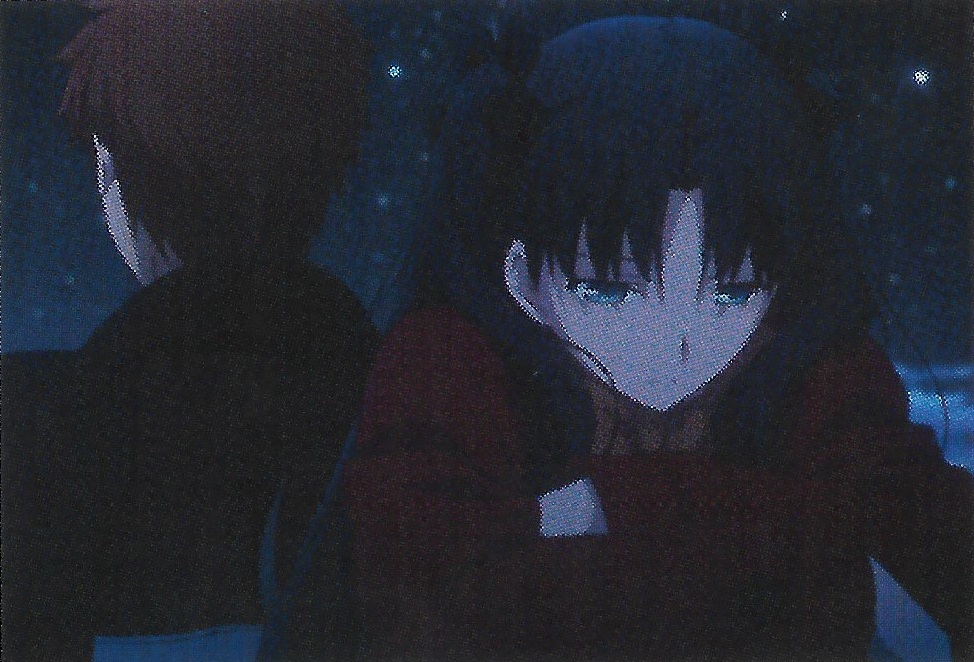
2nd Season Playback
#13 Time of Departure
Season 2 Begins
Nasu: We showed #13 to #15 at an advance screening, so to us they seem like one episode. Regarding #13, it kicks off with a cool, rich OP theme that really brings home the fact that the second season has started, and it’s bursting with events like the Caster battle, Archer’s betrayal, and Rin and Shirou’s bittersweet scene. It was almost like a “Gal game” – while watching it, I kept thinking, “What’s with this gal game-like development? Oh, wait, it did start out as a gal game…”
#14 The Princess of Colchis
Depicted for the first time: Caster’s former Master
Nasu: Atrum is a person whose own interests come first. In other words, he’s a grownup, and by having this kind of Master show up, we show what the Holy Grail War should’ve been like. And the Berserker battle was nothing short of amazing.
Miura: When Gilgamesh appeared, I thought I saw a massive shower of flower petals.
Nasu: So fitting for a King of Heroes, right? And Sella and Leysritt became just as beautiful as those flowers. Regarding those two, you told me when this anime first got the green light that you wanted them to show up.
Miura: For Leysritt and Sella, my instructions to the episode director were to make sure we included a scene somewhere showing them removing their wimples, their headgear. Also, when I asked him to have them murdered in a gruesome way, it turned out to be really cruel.
#15 A Battle of Legend
Showing how “Heroic” Gilgamesh is
Miura: This was something I’d had on my mind the entire time. What I strove for in this episode was not to demean Gilgamesh in any way. The extra line you added, “At the very last minute, did I overcome the legend?” really changed the impression he left.
Nasu: In the visual novel, Gilgamesh was such a straightforward villain. He was cast as the enemy that users could easily hate. But without the premise of the Saber route, I felt that we should show how “Heroic” he could be, as he was in the Saber route. I wanted to show clearly that aspect of him – why he was a hero, despite being a cold-hearted enemy.
Miura: As I was depicting Gilgamesh, rather than see him as a bad guy, what drove me was the thought, “Because he’s a King.”
#16 Winter Days, the Form Wishes Take
A conversation showing glimpses of what’s going through each of their minds
Miura: I think this was the first episode where we got to see what was going on inside the mind of Lancer. So after watching it, and then going back to the start of Season 1, it definitely gives you a different impression. Also, in this episode, there’s a conversation between Archer and Kuzuki.
Nasu: There was an interlude before their next confrontation, so I was given the chance to write that.
Miura: I really like how Archer comes to see him. To Shirou Emiya, Kuzuki had always been an enigma; that’s why Archer comes to talk to him.
Nasu: When people who know who Archer is see this, they’ll be able to tell that he’s referring to that, when they hear his odd way of speaking.
Miura: When you think of what lies ahead, it really is fascinating to see these two standing side by side.
#17 The Dark Sword Bares Its Fangs
Lancer vs. Archer, redux
Miura: This episode was so…as a director, it really was a challenge. Among other things, we had to keep the narrative going.
Nasu: But the beauty of those battle effects was absolutely mind-blowing. I was like, “Hey, Gae Bolg goes “kiiiiiin!” when it returns – that’s so cool! Hey, the church! That’s too much carnage!”
Miura: Well, for that scene we did ramp up the firepower several times, compared to the storyboards. Since we needed to show the fact that “Lancer is incredible.” What I reminded the key animators and directing team was that Lancer had the edge, and I wanted them to make it seem as though Archer was frantically trying to deal with him. Initially, it was like Archer and Lancer’s skills were neck and neck. But that’s not really the case. After all, he is Cú Chulainn.

#18 The Beginning of the Circle
Saber’s ponytail is a big hit
Miura: This is the episode where Archer’s Reality Marble first activates. It was very challenging for us in terms of cinematography, how to depict that. It was a lot of work.
Nasu: And you use it in upcoming episodes as well.
Miura: That was another factor. There were a lot of technical hurdles for us in this episode, like what to do about the gears. Also, you could say that one of the highlights of this episode was Saber’s ponytail.
Nasu: Takashi Takeuchi was totally worked up over that, too! He was like, “What’s that?!”
Miura: According to her specifications, if Saber’s released, she can do whatever she wants with her hair with magic. But since she had a ribbon, we couldn’t help but give her a ponytail. Also, what I liked personally was Rin and Archer’s conversation. As it turned out, this was the last time these two got to really talk to each other.
#19 Idealism’s End
The intent behind Shirou and Archer’s conversation
Miura: In the first storyboards for #19, Lancer was bracing himself when Kirei appeared. But I pointed out how Lancer’s not the type to be intimidated, and asked them to make him calmer, and more antagonistic. Also, in Shirou and Archer’s scene, it was your idea, Mr. Nasu, to have Archer hurl that sword, saying, “Kill yourself, Shirou Emiya.”
Nasu: Those words, “Kill yourself” are laden with one of the reasons why Archer never forcibly killed Shirou himself. In Archer’s view, if Shirou Emiya, who is himself, were to admit to his mistakes and kill himself, it would be the best outcome.
Miura: Having an event like that in the middle of a conversation really helped us out as we were directing it.
#20 Unlimited Blade Works.
Season 2’s battle episode
Miura: As this was an episode featuring battles, we loaded it up from the very beginning. Including that line you wrote, “Hell is up ahead,” we deviated from the visual novel significantly.
Nasu: The first script that ufotable brought to me had a lot of sentences lifted from the original story [the game?], but since we’d end up merely replicating those scenes, I realized that I had to retool it for the anime. But when I rewrote it myself, it was just cool, and not compelling at all. So when I re-read the original, it was totally grim. That was when I realized that that was the essence of UBW, and the lines that took 30 minutes for the characters to utter in-game, I cut down to five. But I had no idea how it would all be brought to the screen, so in my head I was thinking, “Sorry, Mr. Miura,” but it turned out to be a wonderful film, and personally, I’m overjoyed.
#21 answer
Shirou vs. Archer: The outcome of the battle
Miura: Initially, we considered drawing out the battle till #22, but we realized it would be impossible.
Nasu: The showdown had to be settled at the end of #21, or it would’ve been a letdown as a story. So in their minds, they’d decided to battle it out the moment their swords clashed at the end of the previous episode.
Miura: This is something that I personally requested you to add, but the look on Gilgamesh’s face when he was told that Kirei was dead. I wanted so badly to do something for him at that moment, so I put some extra effort into that.
Nasu: Yes, it really was the kind of silence that you could take either way.
Miura: Also, I really liked how Gilgamesh told Shinji in that scene, “You really did great, Shinji.” The king is actually praising him!
Nasu: You can see how highly Gilgamesh regarded Shinji!

#22 Winter Days, a Long Way Home
Saber’s scenes, all-new for the anime version
Nasu: This is where we added new scenes for Saber, written for the anime. We have the scene with Saber and Shirou’s final conversation, and a brief flashback for Saber during the Archer battle. I wrote them so that if you read Garden of Avalon, the bonus novel included in the Blu-ray boxed set, you’ll understand the meaning of Saber’s scenes in this episode.
Miura: The Holy Grail Egg that appears midway through the episode was based on a design we received from TYPE-MOON.
Nasu: Actually, after we’d finished making the game, we created a design for when the Holy Grail was working properly. For this show, we adapted it for use as the defective Holy Grail.
#23 Incarnation
Kojiro’s reason for existing
Miura: There was a lot that I wanted to do with this episode. But the first thing we had to do no matter what was to show Ea’s existence. That, and the expository arc for Kojiro’s Tsubamegaeshi. In order to show viewers what kind of move it was exactly, I thought we’d pull back the camera, and deliberately show the overall view.
Nasu: Since Kojiro started out as a character in the Saber route, there really isn’t much point in UBW for him to exist as an enemy Servant. But he did have another reason to exist that made him indispensable, and that was his dialogue with Saber at the end. Kojiro’s great quest to save the world, and his simple desire to engage in the battle of a lifetime were one and the same. Even if these wishes differed in size, the amount of passion he felt for them was the same. That’s why Saber apologizes to Kojiro, “Pardon me,” and reciprocates.
#24 unlimited blade works
At last, the final phase
Miura: You gave us a lot of advice regarding this episode. Rin and Archer’s farewell scene may look merely beautiful at a glance, but in fact it’s quite cruel. I was also impressed by what you said about the casual conversation between Shirou and Saber. It’s pulled off so smoothly, but they’re actually saying goodbye for good.
Nasu: Right. Even though he knows he’ll never see Saber again, he says, “We’ll talk later.” Like reincarnation…all living creatures eventually go somewhere in the end, so they might be reunited. That’s why Saber makes a point of saying such a thing. I did ask you to make sure that came across.
#25 Epilogue
The epilogue we arrived at through the London episode
Miura: For the broadcast of the finale, I didn’t think there’d be a point watching it at home, so I decided to watch it at the office. And once I started, more and more people started gathering around, and in the end, we all watched it together. That really made me happy.
Nasu: Also, the anime Rin is a bit sweeter than in the visual novel. That’s okay, isn’t it? I can hardly hide the smirk on my face!
Miura: One misstep, and it could’ve been the honeymoon episode, but in the end, it wrapped up Shirou Emiya’s story nicely, and since we were able to stick with our theme, I was relieved as the show’s director.
Nasu: Personally, I had two absolute conditions for myself when I was writing the finale. First, explain what the Holy Grail War meant to them. Second, what was Saber in UBW to Shirou? But rather than have him drone on and on to her grave, I wanted him to just call out to her once. And you did a great job realizing that on film.

Production Note
Cinematography – Behind-the-scenes
In animation, the visuals are completed after a process called finishing = mainly painting. Here, we’re going to show you the materials after painting, and after they’ve been processed further during the shoot – the finalized versions of the materials.

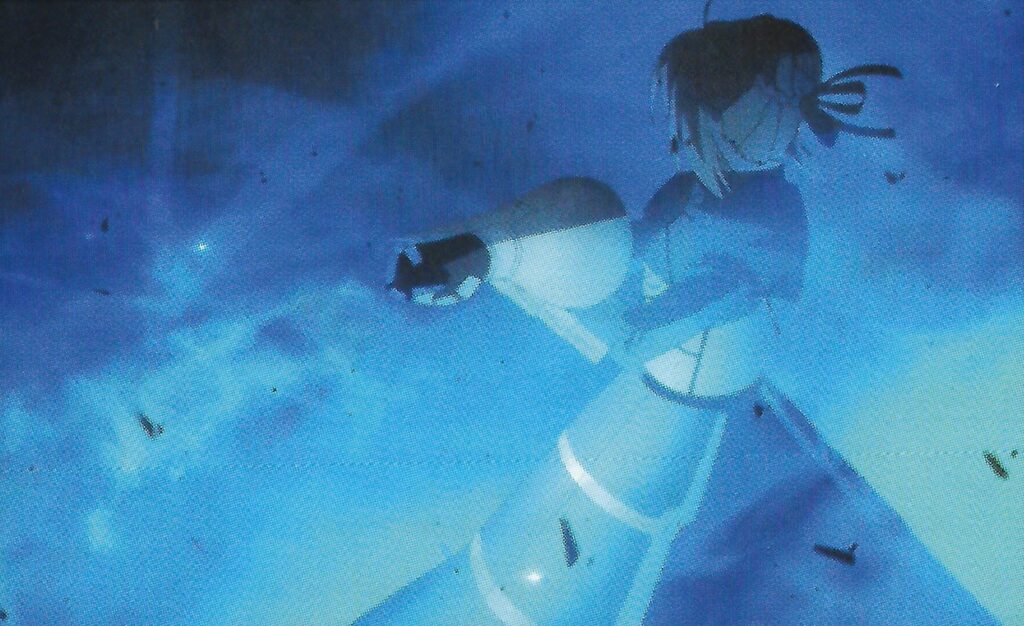
The smoke effects for Saber’s summoning scene. Blue lighting was used to lend beauty to the visuals. I thought the contrast between the completely immobile Saber and the smoke swirling around her in a complex manner would look striking. This visual is a blend of animation + CG.
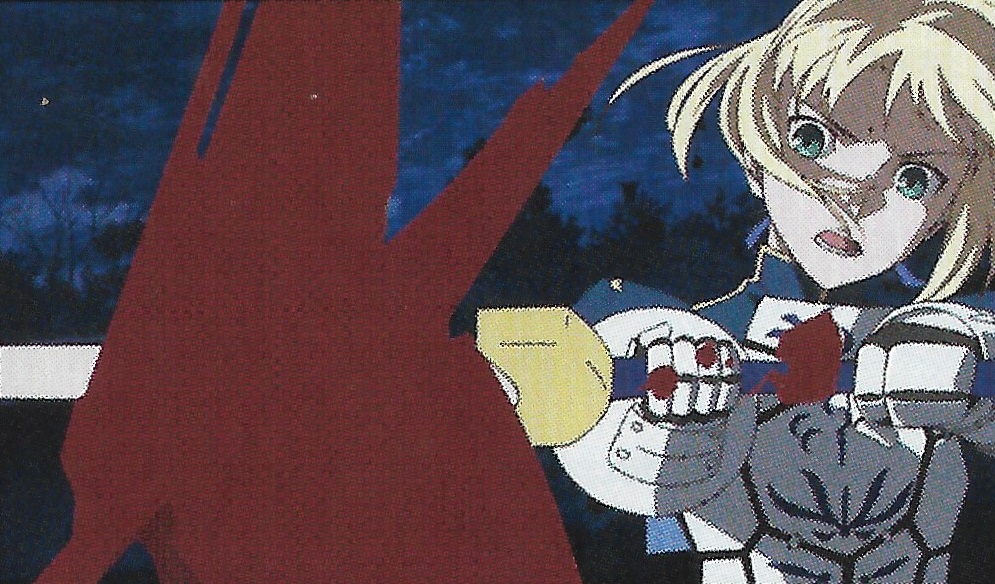
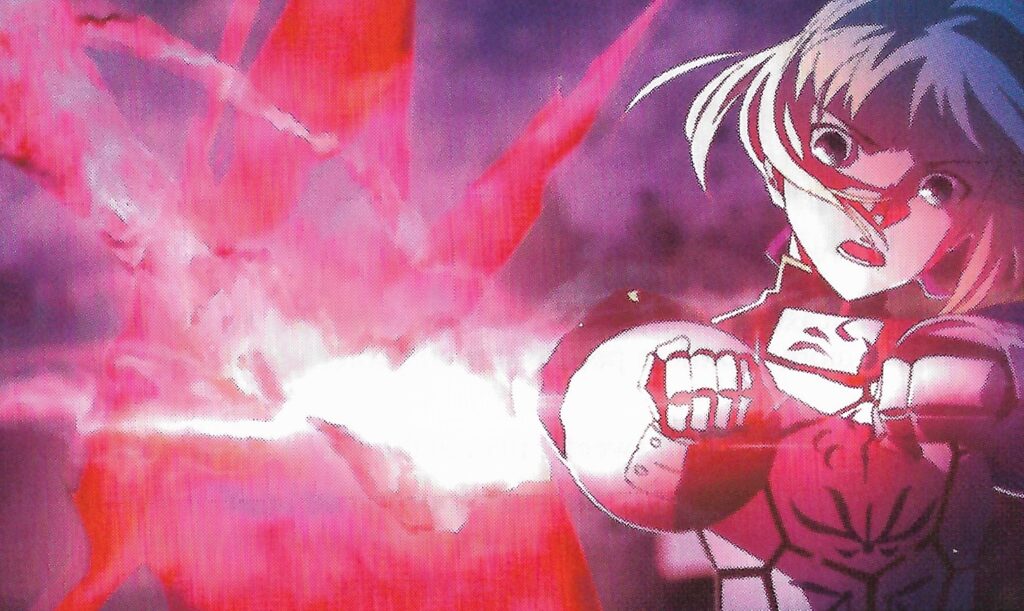
Gae Bolg is a dangerous curse = a space warped by red light…that’s what we set out to shoot. Within the sequence of shots the red tinted visuals would switch to blue, particles and noise would appear and disappear subtly onscreen; there was a mix of numerous effects in that short scene.

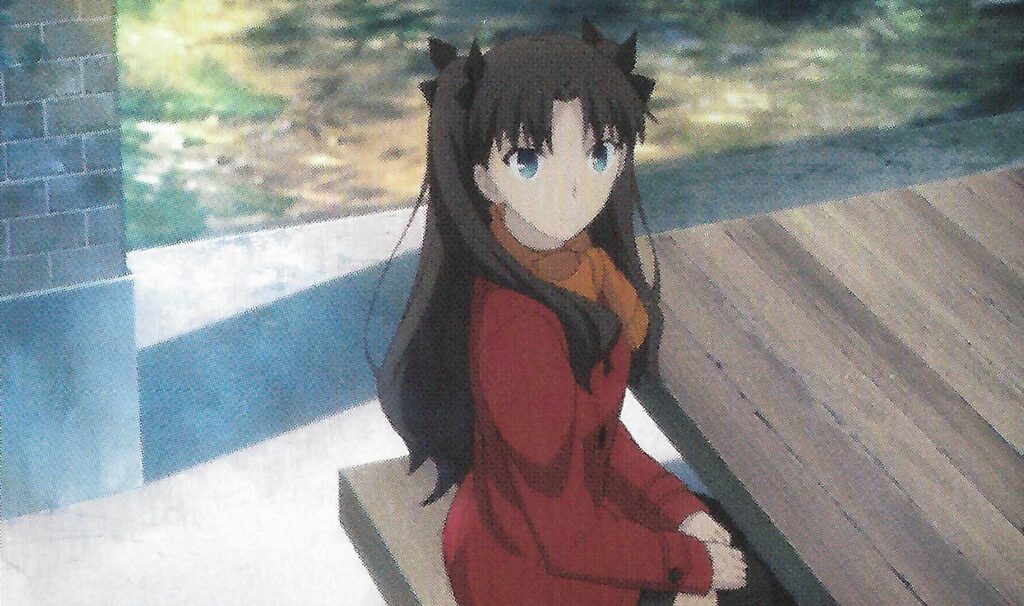

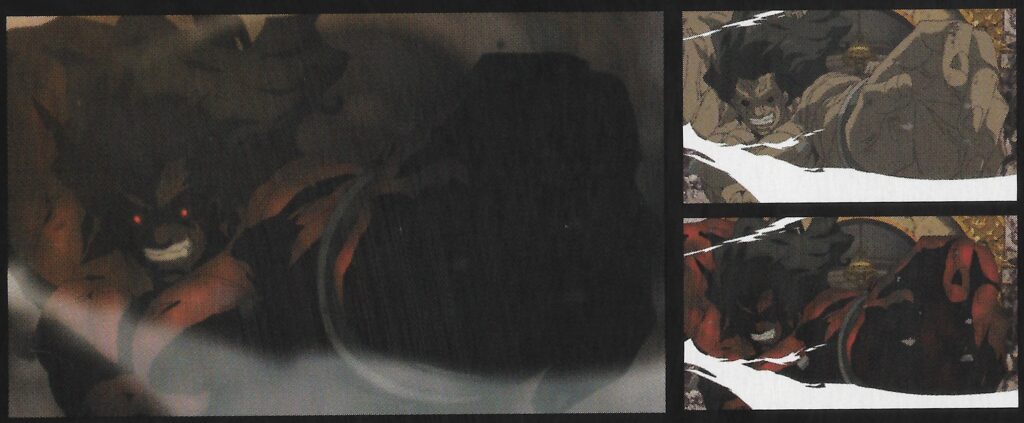
It’s difficult to distinguish Berserker’s body surface in stills, but along with the bumps and dents in his body, the red pattern itself is mapped as it undulates. We pursued this stereoscopic effect during the shoot, matching it to the animation.
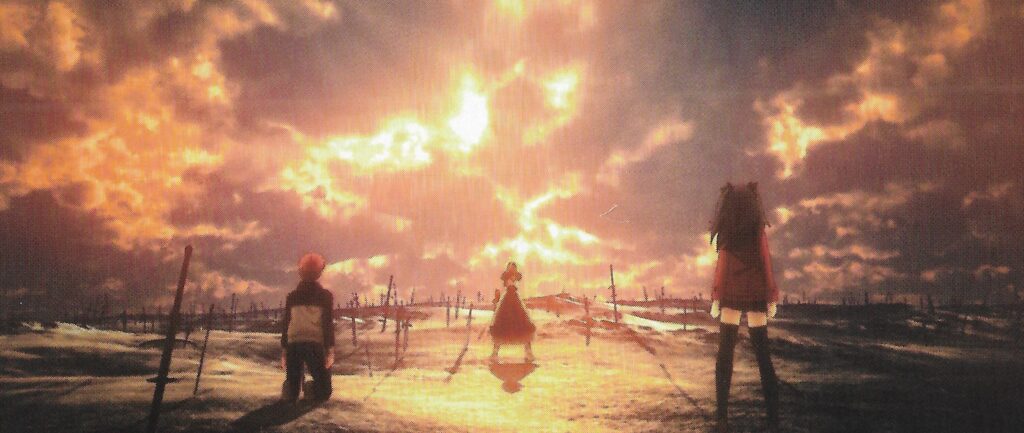
The striking depiction of clouds in the Reality Marble was achieved through CG. But in this shot, although the ground is also CG, its base is Mr. Eto’s artboards. The staff took great pains with this shot in order to achieve a hand-drawn look, while maintaining all the details.
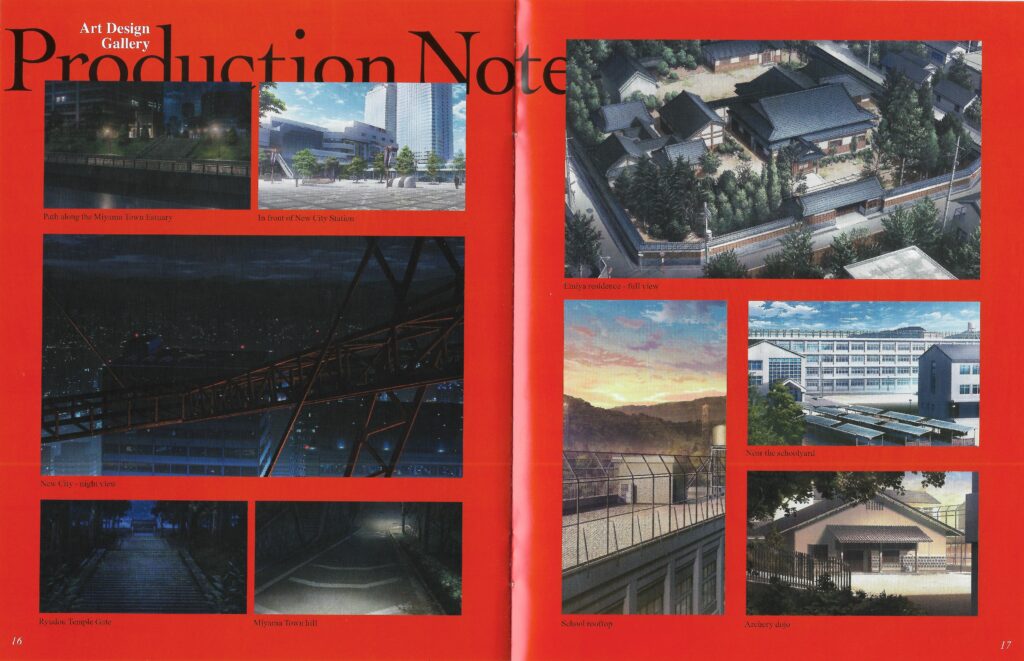
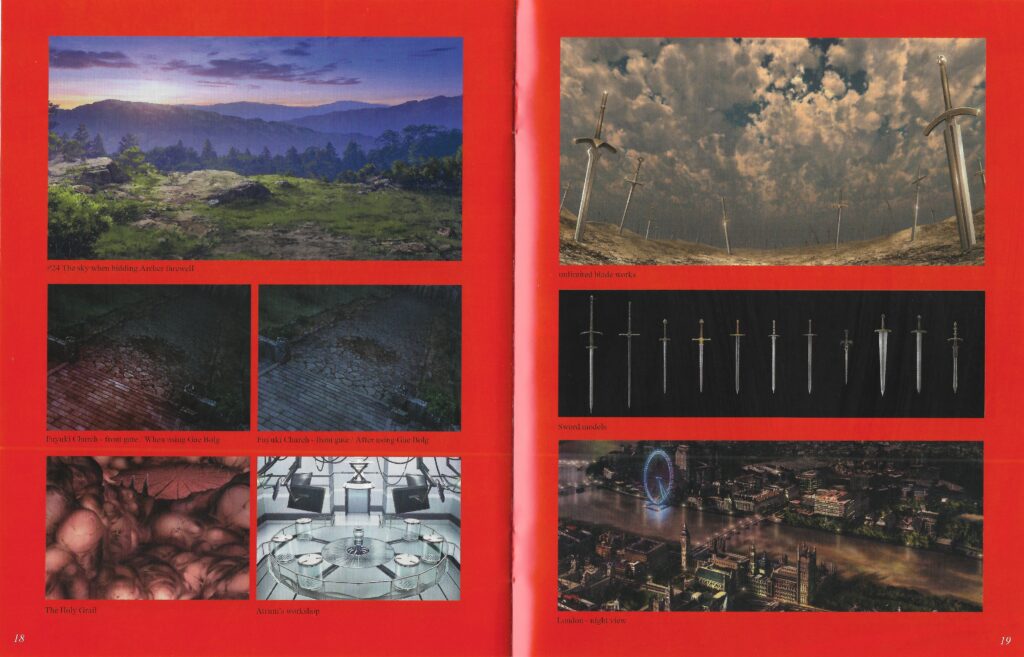
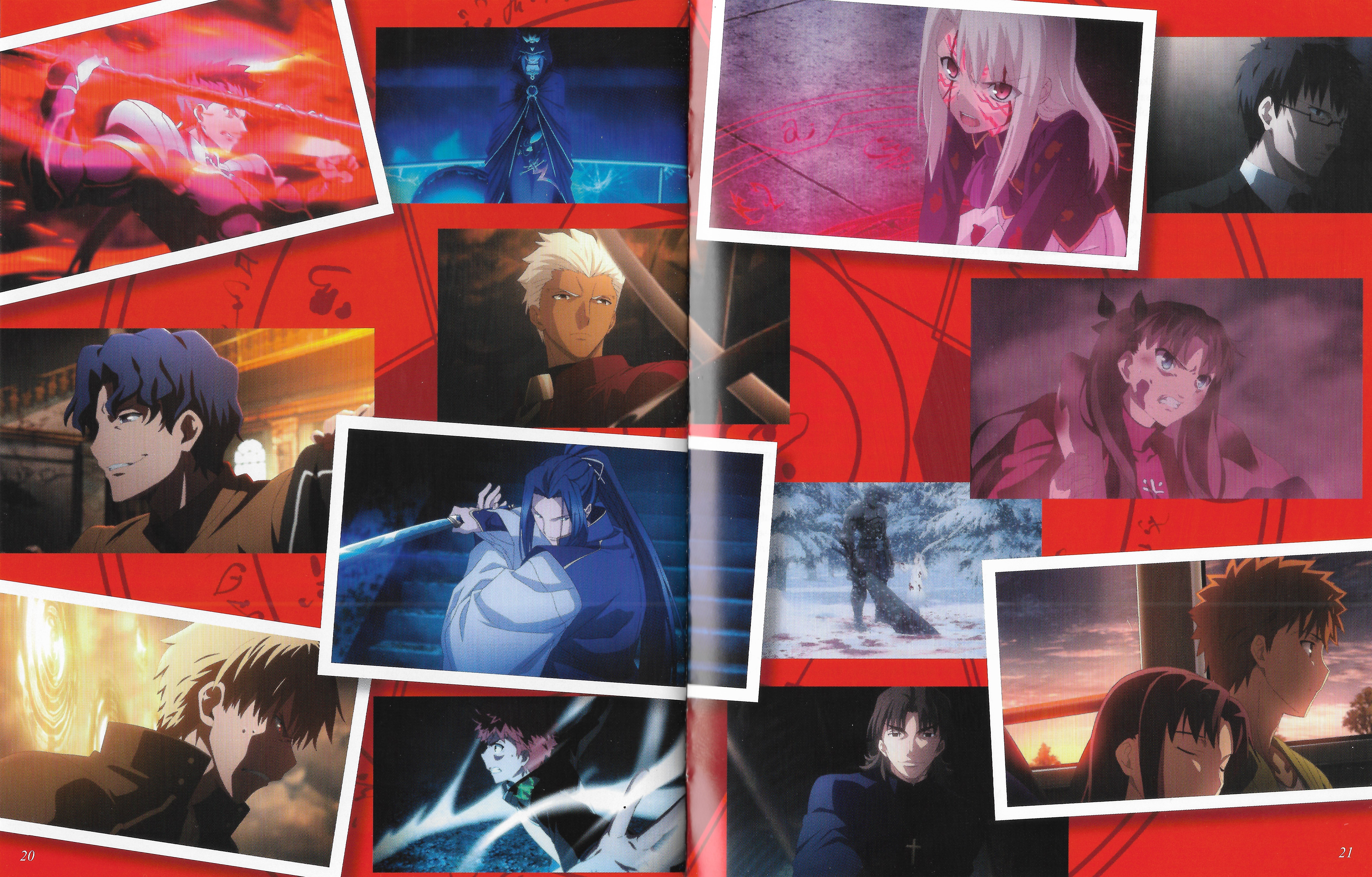
STAFF
Original Story: Kinoko Nasu / TYPE-MOON
Director: Takahiro Miura
Original Character Design: Takashi Takeuchi
Character Design: Tomonori Sudo, Hisayuki Tabata, Atsushi Ikariya
Color Setting: Emi Chiba, Mika Matsuoka
Art Director: Koji Eto
Director of Photography: Yuichi Terao
Music: Hideyuki Fukasawa
3D Director: Kojiro Shishido
Animation Production: ufotable
Opening Theme Song: “Brave Shine” by Aimer (DefSTAR Records)
Ending Theme Song: “ring your bell” by Kalafina (SME Records)
#15 Ending Theme: “ring your bell (in the silence)” by Kalafina (SME Records)
#20 Inserted Song: “LAST STARDUST” by Aimer (DefSTAR Records)
CAST (Japanese / English)
Shirou Emiya: Noriaki Sugiyama / Bryce Papenbrook
Rin Tohsaka: Kana Ueda / Mela Lee
Saber: Ayako Kawasumi / Kari Wahlgreen
Archer: Junichi Suwabe / Kaiji Tang
Sakura Matou: Noriko Shitaya / Cristina Vee
Illyasviel von Einzbern: Mai Kadowaki / Stephanie Sheh
Souichirou Kuzuki: Masaki Terasoma / Lex Lang
Lancer: Nobutoshi Kanna / Tony Oliver
Caster: Atsuko Tanaka / Megan Hollingshead
Assassin: Shinichiro Miki / Todd Haberkorn
Rider: Yu Asakawa / Melissa Falm
Taiga Fujimura: Miki Ito / Julie Ann Taylor
Shinji Matou: Hiroshi Kamiya / Kyle McCarley
Issei Ryudou: Mitsuaki Madono / Robbie Daymond
Kirei Kotomine: Joji Nakata / Crispin Freeman
Kiritsugu Emiya: Rikiya Koyama / Matthew Mercer
Gilgamesh: Tomokazu Seki / David Earnest
Atrum Galliasta: Jun Fukushima / Robbie Daymond
Irisviel von Einzbern: Sayaka Ohara / Bridget Hoffman
Leysritt: Miho Miyagawa / Brianna Knickerbocker
Sella: Haruhi Nanao / Rachael McCabe
Shirou Emiya (child): Junko Noda / Mona Marshall
Ayako Mitsuzuri: Fumie Mizusawa / Brina Palencia
Yukika Saegusa: Eri Nakao / Jessica DiCicco
Kaede Makidera: Michiru Yuimoto / Erica Lindbeck
Kane Himuro: Rie Nakagawa / Dorothy Fahn
Luvia: Shizuka Ito / Lauren Landa
Lord El-Melloi the Second: Daisuke Namikawa / Lucien Dodge
ADR Script Writers: Tony Oliver, Michael McConnohie, Joel McDonald
English Voice Director: Tony Oliver
DISC 1
#13 Time of Departure
#14 The Princess of Colchis
#15 A Battle of Legend
#16 Winter Days, The Form Wishes Take
DISC 2
#17 The Dark Sword Bares Its Fangs
#18 The Beginning of the Circle
#19 Idealism’s End
#20 Unlimited Blade Works.
DISC 3
#21 answer
#22 Winter Days, A Long Way Home
#23 Incarnation
DISC 4
#24 unlimited blade works
#25 Epilogue
OVA “sunny day”
Extras (Bonus Contents)
DISC 5
Original Soundtrack II
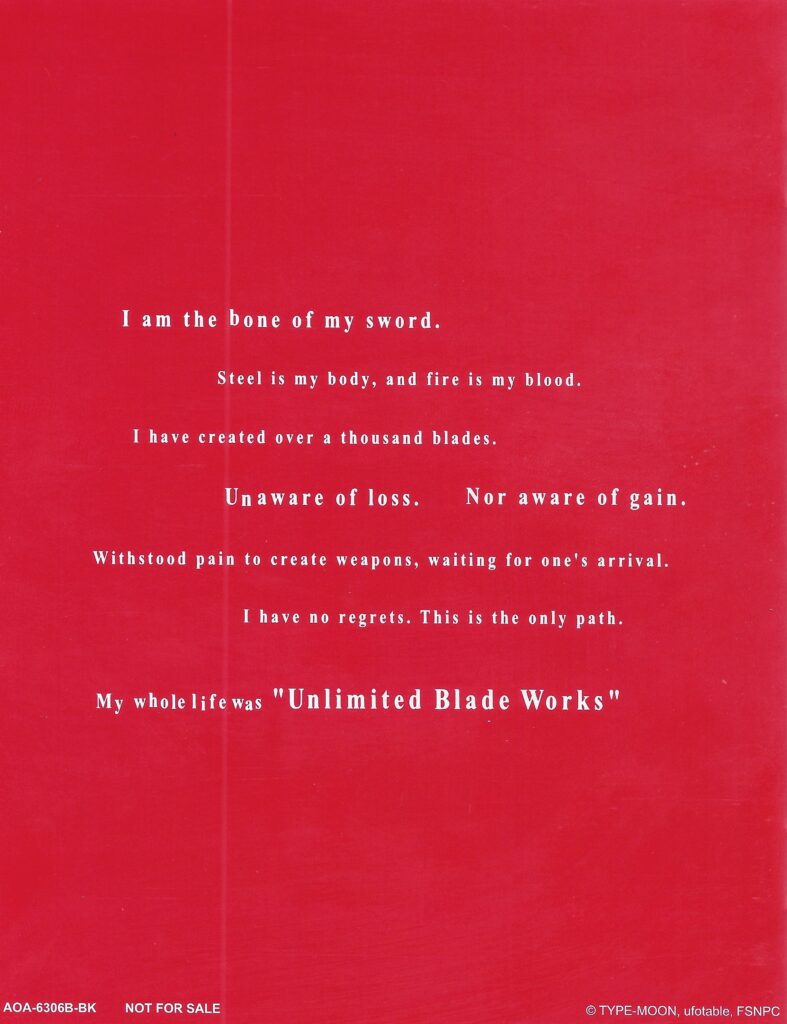
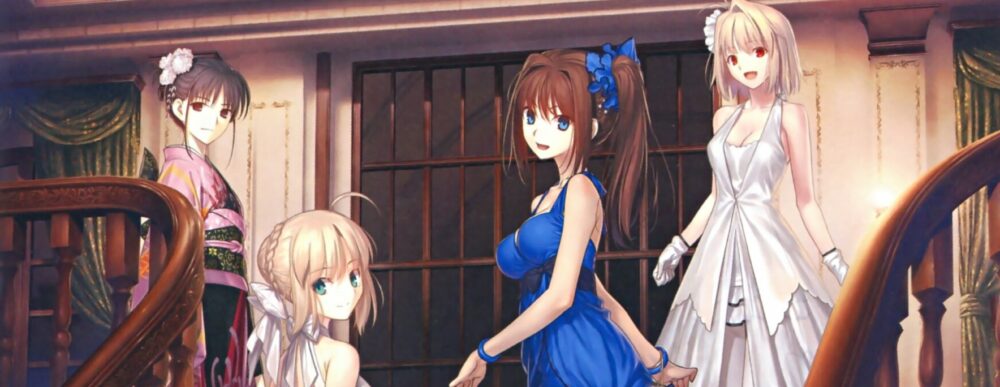
Any plans for the Fate/Zero, Fate/stay night [UBW], Heaven’s Feel and Fate/Apocrypha booklets?
Fate/Zero – Animation Material II
http://www.mediafire.com/file/e1p0cbg19mb5enh/Fate_Zero_BD_II_English.zip/file
Fate/stay night [UBW] – Animation Material I
https://anidb.net/forum/thread/56958
Fate/stay night [UBW] – Kinoko and Takashi Q&A
https://www.tsukikan.com/misc/kinoko-and-takashi-q-a-fate-stay-night-unlimited-blade-works.html
Fate/stay night [UBW] – Animation Material II
https://imgur.com/a/zzgtH
Fate/stay night [Heaven’s Feel] – Animation Material I
https://imgur.com/a/yhv4ZNd
hello, your site is so good.Following your posts.